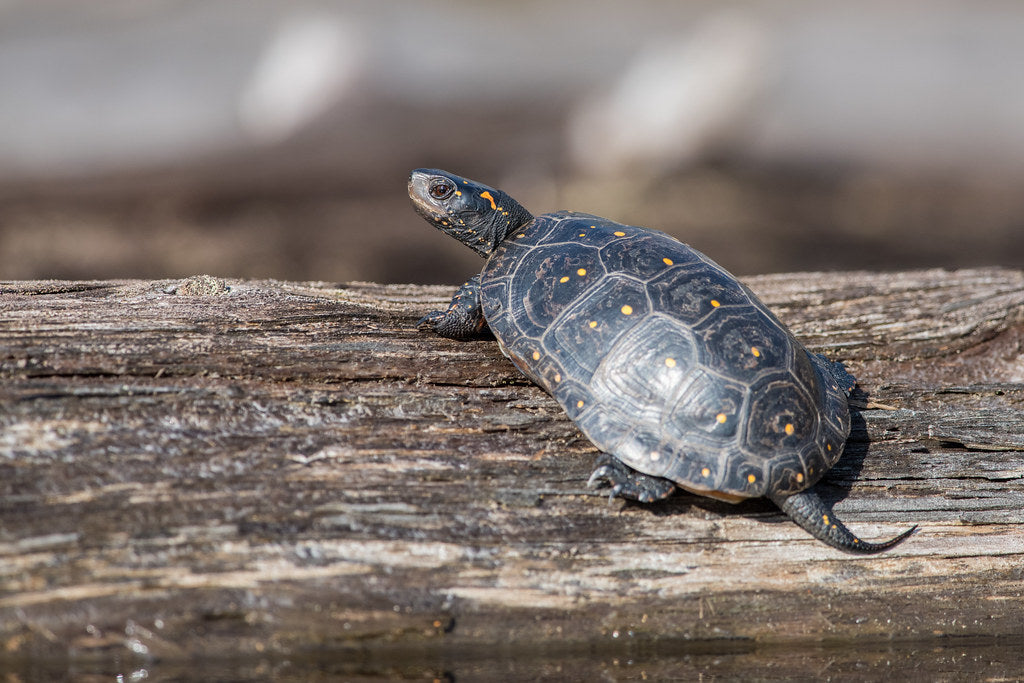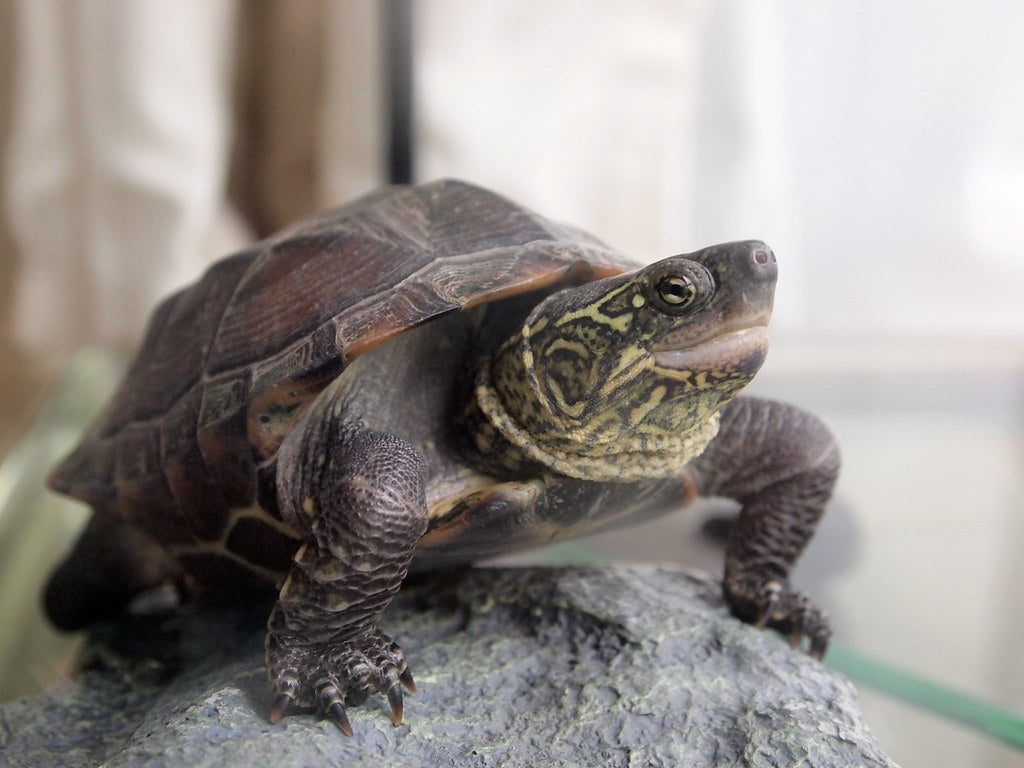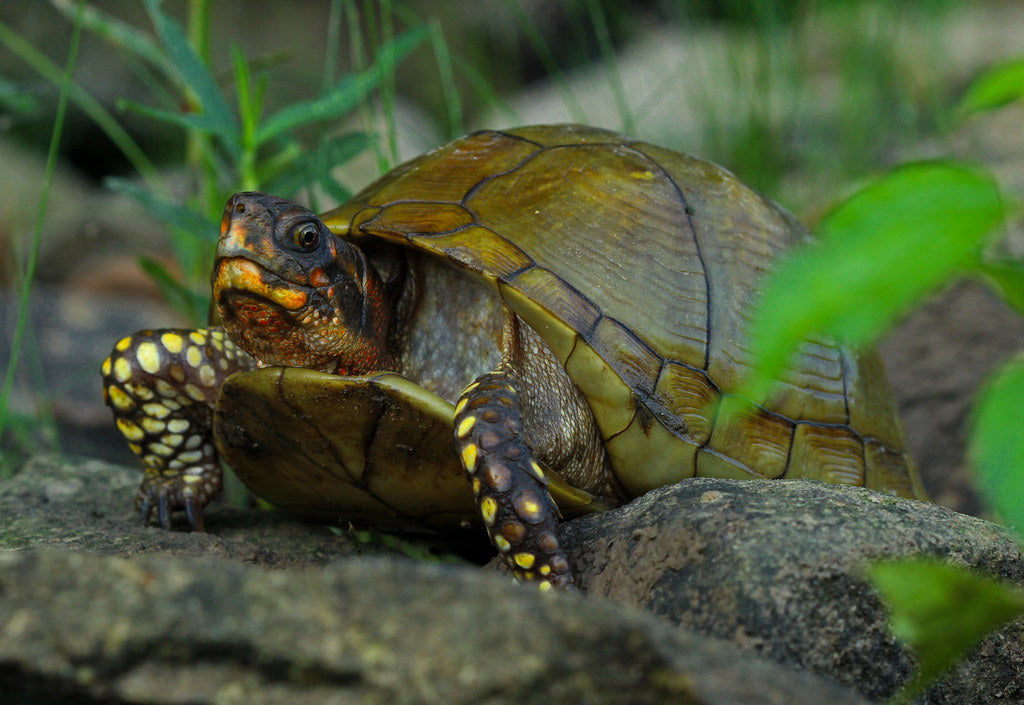The spotted turtle (Clemmys guttata) is a small, semi-aquatic reptile found along the eastern coast of the United States, as well as most of the Great Lakes area. They prefer quiet, slow-flowering bodies of water with plenty of vegetation, including swamps, marshes, streams, and drainage ditches.
Spotted turtles are generally 4.5-5.5” long, with oval heads, streamlined shells, and long tails. They are most identifiable by their unique coloring, which is black with small yellow dots. The underside of their limbs may have orange-pink coloring, and younger individuals usually have less color on their plastron than older ones.
Spotted turtles can make good beginner-level pet turtles because of their size, but beware: they are known to live well past 50 years, and possibly up to 100+!
Note: Spotted turtles may be native to the US, but that is not a reason to take one from the wild! If you want a pet spotted turtle, purchase one from a breeder. Never take reptiles from the wild!
How much space do spotted turtles need?
The minimum enclosure size for appropriately keeping one adult spotted turtle is roughly 36”L x 18”W x 18”H. However, this is just the minimum, and providing a larger enclosure is both beneficial and appreciated!
Spotted turtles are known to spend a significant amount of time on land, so it’s best practice to use a Waterland tub or similar instead of an aquarium, so you can provide plenty of land area for roaming around, and moist soil for burrowing. This also provides a readily-available area of land for females to routinely deposit infertile eggs as needed (similar to a chicken).
Roughly 50% of the enclosure should be water. Water depth should be shallow enough to allow the turtle to breathe from the surface if it stands on its tiptoes from the bottom of the tank — this is especially important for hatchlings, which are weaker swimmers than adults.
Spotted turtles tend to do well when housed outdoors where local climate permits, even if it’s just during part of the year. This is a convenient way to provide your turtle with a generously-sized pond and “free” heating and lighting.
It’s best not to house multiple spotted turtles in the same enclosure.
Do spotted turtles need UVB?
Spotted turtles require regular exposure to high-quality UVB in order to maintain optimal health and wellbeing. Providing UVB lighting to your turtle gives them all of the vitamin D that their body needs, stimulates better appetite and activity, and strengthens the immune system, as well as other benefits.
The best UVB bulbs for spotted turtles are:
- Zoo Med Reptisun T5 HO 5.0
- Arcadia Forest 6%
The UVB bulb should be half the length of the enclosure and housed in a reflective fixture like the Arcadia ProT5 or Vivarium Electronics. Place the lamp close to the heat lamp. If it’s on top of a screen lid, the basking platform should be placed so the top of the turtle’s shell is 6-9” from the lamp. If there is no screen obstruction, the lamp should be placed so the top of the shell is 11-12” below.
UVB bulbs decay over time, so don’t forget to replace your bulb every 12 months to maintain good performance. If you are housing your turtle outdoors in an appropriate climate, supplementary lighting is not required.
It’s also a good idea to provide a strong LED or T5 HO 6500K daylight lamp for additional illumination. This helps better replicate daylight and is also good for any live plants you may be using. “Nighttime” lighting such as colored light bulbs should not be used.
Lights should be on for 14 hours/day during summer and 10 hours/day during winter, with gradual adjustments in-between.
What basking temperatures do spotted turtles need?
Spotted turtles are ectotherms, which means that they rely on the variable temperatures of their environment to help regulate their metabolism and stay healthy.
Temperature gradient for spotted turtles:
- Basking area (air temp) — 86-90°F
- Water temp — 70-80°F
Measure basking temperature with a digital probe thermometer, and water temperature with a high-quality aquarium thermometer.
A good way to warm the basking area is with a halogen flood heat lamp placed on one side of the enclosure and positioned over the basking area. Do not use ceramic heat emitters (CHEs), red bulbs, or blue bulbs, as these are not as effective. Increase the wattage if they’re too cool, and use a plug-in lamp dimmer if they’re too warm.
If you need to heat the water, use a high-quality aquarium heater rated for at least the maximum volume of water in the enclosure.
If you are housing your turtle outdoors, supplementary heating should not be required. However, if your area experiences a significant drop in temperature during winter, you will need to make sure your pond is equipped to allow your turtle to hibernate safely, or bring them inside once the weather starts to get colder.
What water conditions do spotted turtles need?
The water in your enclosure should still be kept clean at all times in order to keep your turtle healthy. The most efficient way to do this is with a combination of excellent filtration and regular water changes.
Aquatic turtles are fairly messy creatures, so you will need a canister-style filter capable of handling at least 2-3x the amount of water in the enclosure. So, if you have an aquarium or pond with 20 gallons of water, you will need a filter rated for at least 40 gallons of water. Don’t settle for the cheapest filter you can find — this is one aspect of your turtle’s enclosure not to skimp on!
Use a low-flow aquarium filter designed for fish that prefer stagnant water, as spotted turtles don’t like a strong current. If you can’t find something suitable, place a rock or similar directly under the filter’s output to disrupt the current.
Once every 1-2 weeks, remove and replace approximately 30% of the aquarium/pond’s total water volume. This helps minimize buildup of toxic compounds in the water that a filter is unable to resolve. To make the job easier, use a siphon or water pump.
Both indoor and outdoor turtle ponds require filtration and water changes.
What substrate is good for spotted turtles?
Roughly 50% of a spotted turtle’s enclosure should be an easily-accessible land area for the turtle to climb up on, bask, and crawl around. Use a deep layer of moist, sandy soil for this area, particularly if the turtle is being kept outdoors. You can do this with Zoo Med Reptisoil or by mixing your own substrate with approximately 80% clean topsoil and 20% play sand (measured by volume).
Substrate is not required in the aquatic portion of the enclosure, although it does offer a form of enrichment when provided, encouraging natural behaviors. Fine sand makes for the best aquatic substrates for spotted turtles. Avoid using gravel or small pebbles.
Leaf litter and sphagnum moss can be used both on the land and in the water.
What décor can you use in a spotted turtle enclosure?
There are many ways you can increase your enclosure’s functionality and general attractiveness both on land and in the water. Here are some ideas:
- live/artificial plants
- driftwood
- hollow logs
- terracotta pots
Spotted turtles are quite dependent on having plenty of vegetation in their water, so don’t be afraid to fill it up with live or artificial plants. Note, however, that if you use artificial plants, they need to be sturdy enough not to come apart if the turtle tries to take a bite!
Make sure your turtle has access to places where it can hide from view as needed. Make sure objects with holes or tunnels in them are large enough to accommodate the turtle’s maximum size, as it can drown if it gets stuck!
What do spotted turtles eat?
Spotted turtles are omnivores, which means that they need to eat a balanced diet of both plant- and animal-based foods to get the nutrition that they need. However, most of their diet should be animal protein, especially when they’re hatchlings.
Young and growing spotted turtles should receive protein-rich food or pellets daily to every other day, with greens being offered daily. Adults should receive protein-rich food or pellets 2-3x/week, with greens daily.
Offer as much animal-based food as your turtle will eat in 5-10 minutes. A portion of chopped/shredded vegetables should be roughly the same size as the turtle’s shell. A portion of pellets should be roughly the same size as the turtle’s head. Beware of overfeeding — if your turtle starts to look chubby, reduce the amount of food offered at each feeding.
Animal-based foods for spotted turtles: crickets, earthworms, dubias, discoids, shrimp/krill, bloodworms, mealworms, hornworms, silkworms, snails
Vegetable foods for spotted turtles: spirulina algae wafers, duckweed, pond lily, eelgrass, water hyacinth, collard greens, dandelion greens, endive, green leaf lettuce, kale, red leaf lettuce, romaine lettuce, cranberries, filamentous algae
Pellets for spotted turtles: Omega One Juvenile Turtle Pellets, Omega One Adult Turtle Sticks, Tetra ReptoMin, Zoo Med Natural Aquatic Turtle Food, Mazuri Aquatic Turtle Diet
Do spotted turtles like to be handled?
As a general rule, turtles do not like to be handled, so it’s best to keep the handling to a minimum. If you would like to interact with your turtle, try hand-feeding it with a pair of feeding tongs.
*This care sheet contains only very basic information. Although it’s a good introduction, please do further research with high-quality sources to obtain additional information on caring for this species.
"Spotted Turtle, Clemmys guttata (Schneider, 1792)" by Misenus1 is licensed under CC BY-NC-SA 2.0




Leave a comment
This site is protected by hCaptcha and the hCaptcha Privacy Policy and Terms of Service apply.